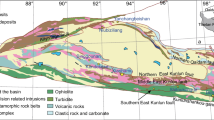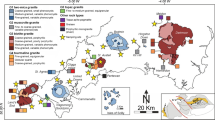Abstract
This paper reports the geochemical characteristics of PGE- and Au-bearing carbonaceous shales of the Sutyr and Kimkan sequences from the eastern Bureya Massif in the Russian Far East. The weakly altered shales are chemically close to the average upper crustal shale (NASC) but differ in the lower contents of iron, manganese, magnesium, phosphorus, calcium, and REE. According to the discrminant diagrams, these sediments are similar to the modern sediments accumulated under the influence of the continental terrigenous runoff, suprasubduction volcanism, and seawaters, which suggest their relation either with the deep-water trench near the active continental margin or with the central part of the marginal sea. The iron-rich sedimentary rocks of the Kimkan Sequence, including the Kimkan iron ore, are characterized by a positive Eu anomaly, which probably indicates their rift origin. The superimposed hydrothermal alterations of the Sutyr Sequence, including sericitization, sulfidization, and formation of quartz veinlets, were accompanied by the removal of silica and the input of potassium, LREE, and MREE with the formation of a well expressed Eu anomaly. The rocks from the weakly altered to metalliferous sediments of the Kimkan Sequence show a decrease in alkalis and especially in potassium. The carbon isotope composition of the Sutyr shales corresponds to that of the biogenic carbon (δ13CVPDB from −20.7 to −23.7‰). The shales of the Kimkan Sequence have a heavier carbon isotope composition (δ13CVPDB from −15.6 to −19.1‰), which may indicate either partial carbon influx from an endogenous source or its formation during decarbonatization in the presence of iron.
Similar content being viewed by others
References
T. N. Aleksandrova, A. A. Cherepanov, and N. V. Berdnikov, “Results of mineralogical and technological study of precious metal mineralization in the carbonaceous rocks of the Sutyr and Kimkan sequences of the Bureya Massif,” in Problems of Complex Development of Georesources: Proceedings of 4th All-Russian Conference with Participation of Foreign Scientists, Khabarovsk, Russia, 2011 (IGD DVO RAN, Khabarovsk, 2011), vol. 1, pp. 229–235 [in Russian].
Yu. A. Balashov, Rare-Earth Element Geochemistry (Nauka, Moscow, 1976) [in Russian].
N. V. Berdnikov, “Finely-dispersed gold and PGM in the graphite shales of the Bureya terrane: a new type of precious metal mineralization at the Russian Far East,” Vesti ONZ RAN 2(NZ100004) (2010). doi:10.2205/2010NZ000051.
N. V. Berdnikov, N. S. Konovalova, and V. E. Zazulina, “Investigation of precious metal inclusions in highly carbonaceous rocks by the SEM and X-Ray spectrum analysis methods,” Russ. J. Pac. Geol. 4(2), 164–170 (2010).
O. V. Vikent’eva, “REE in the metasomatic rocks of mesothermal gold deposits,” in Role of Mineralogy in Knowledge of Ore Formation: Proceedings of Annual Session of Moscow Division of the Russian Mineralogical Society Dedicated to the 110th Anniversary of Academician A.G. Betekhtin, Moscow, Russia, 2007 (IGEM RAN, Moscow, 2007), pp. 76–80 [in Russian].
Geodynamics, Magmatism, and Metallogeny of East Russia, Ed. by A. I. Khanchuk (Dal’nauka, Vladivostok, 2006) [in Russian].
Geology of USSR. Khabarovsk Krai and Amur Oblast (Nedra, Moscow, 1966), Vol. 19, Part 1, p. 736 [in Russian].
Deep Structure and Metallogeny of East Asia, Ed. by A. N. Didenko, Yu. F. Malyshev, and B. G. Saksin (Dal’nauka, Vladivostok, 2010) [in Russian].
E. G. Gurvich, Metallogeny of Sediments of the World Ocean (Nauch. mir, Moscow, 1998) [in Russian].
L. I. Gurskaya, PGM Black-Shale Mineralization and Criteria for its Prediction (VSEGEI, St. Petersburg, 2000) [in Russian].
A. V. Dubinin, Geochemistry of Rare-Earth Elements in Ocean (Nauka, Moscow, 2006) [in Russian].
G. A. Karpov, A. G. Nikolaeva, and Yu. V. Alekhin, “Abundances and sources of rare-earth elements in the modern volcanogenic hydrothermal systems of Kamchatka,” Petrology 21(2), 145–157 (2013).
E. Kh. Korish and K. A. Savko, “Geochemistry of highly carbonaceous shales of the Tim-Yastre-bovskaya structure, Voronezh crystalline massif,” Vestn. Voronezh. Univ., Geol., No. 2, pp. 108–116 (2010).
Yu. F. Malyshev, “Types of the East Asian crust and their geological interpretation,” Tikhookean. Geol. 20(6), 3–16 (2001).
V. N. Matvienko, Yu. D. Kalashnikov, and V. A. Narseev, “Clusters as a protoform of the occurrence of precious metals in ores and mineralized rocks,” Rudy Met., No. 5, 28–36 (2004).
V. G. Nevstruev and N. V. Berdnikov, “Petrochemical criteria for precious metal mineralization in carbonaceous shales in the east Bureya Massif,” in Problems of Complex Extraction of Georesources: Proceedings of All-Russia Conference, Khabarovsk, Russia, 2011 (Khabarovsk, 2011), Vol. 2, pp. 228–232 [in Russian].
L. M. Parfenov, N. A. Berzin, A. I. Khanchuk, et al., “Models of the formation of orogenic belts in Central and Northeastern Asia,” Tikhookean. Geol. 22(6), 7–41 (2003).
O. V. Petrov, S. S. Shevchenko, and A. M. Akhmedov, “New economic types of complex ores of noble and nonferrous metals in the Precambrian of the eastern Baltic Shield,” in Geodynamics, Magmatism, Sedimentogenesis, and Metallogeny of Northwest Russia (KarNTs, Petrozavodsk, 2007), pp. 292–296 [in Russian].
L. P. Plyusnina and T. V. Kuz’mina, “Modeling of gold and platinum chemosorption on graphite synthesized from bitumoids,” in Proceedings of 15th All-Russia Conference on Experimental Mineralogy (Syktyvkar, 2005), pp. 397–398 [in Russian].
O. G. Reznikova, “Distribution of rare-earth elements in BIFs of the Lebedinskoe deposit, KMA,” in Geology of 21st Century: Proceedings of 9th All-Russian Conference of Students, Post-Graduate Students, and Young Scientists, Saratov, Russia, 2008 (Saratov, 2008), pp. 66–67 [in Russian].
O. G. Reznikova, B. C. Kuznetsov, and V. V. Abramov, “Distribution of trace elements in sulfidized iron quartzites and shales of the Stoilenskoe deposit, KMA,” Vestn. Voronezh. Univ., Geol., No. 2, 117–127 (2010).
A. A. Tomilenko, N. A. Gibsher, O. A. Koz’menko, et al., “Lanthanides in fluid inclusions, quartz, and greenschists from auriferous and barren quartz-vein zones of the Sovetskoe quartz-gold deposit, Yenisei Range, Russia,” Geochem. Int. 46(4), 402–408 (2008).
A. I. Khanchuk, “Tectonics and magmatism of the paleotransform Californian-type margins on East Russia. General tectonic problems,” in Tectonics of Russia: Proceedings of 33rd Tectonic Conference, Moscow, Russia, 2000 (GEOS, Moscow, 2000), pp. 544–547 [in Russian].
A. I. Khanchuk, N. V. Berdnikov, A. A. Cherepanov, et al., “First finds of platinoids in black-shale sequences of the Bureya Massif (Khabarovsk Region and Jewish Autonomous Okrug),” Dokl. Earth Sci., 425(2), 213–215 (2009).
A. I. Khanchuk, A. N. Didenko, I. Yu. Rasskazov, et al., “Graphite shales as promising noble metal source on the Russian Far East,” Vestn. DVO RAN, No. 3, 3–12 (2010).
N. M. Chernyshov, “Nature of carbon and ore matter in the gold-PGM ore-forming systems in the stratified black shales of VCM,” Vestn. Voronezh. Univ., Geol., No. 12, 149–153 (2001).
V. A. Shatrov, G. V. Voitsekhovskii, and A. N. Zelenskaya, “Distribution of the rare-earth and trace elements in BIFs, weathering crusts, and sedimentary iron ores: evidence from the Lebedinskoe and Mikhailovskoe iron ore deposits of KMA,” Vestn. Voronezh. Univ., Geol., No. 12, 69–80 (2001).
V. A. Shatrov, “Reconstruction of sedimentation settings of the Lower Proterozoic metasedimentary rocks using rare-earth elements: evidence from East European Platform,” Vestn. Voronezh. Univ., Geol., No. 1, 38–42 (2004).
L. P. Gromet, R. F. Dymeck, L. A. Haskin., et al., “The “North American Shale Composite”: its compilation, major and trace element characteristics,” Geochim. Cosmochim. Acta 48, 2469–2482 (1984).
K. Hayashi, H. Fujisawa, H. D. Holland, et al., “Geochemistry of ∼1.9 Ga sedimentary rocks from Northeastern Labrador, Canada,” Geochim. Cosmochim. Acta 61(19), 4115–4137 (1997).
H. Kucha and W. Przylowicz, “Noble metals in organic matter and clay-organic matrices, Kupferschiefer, Poland,” Econ. Geol. 94(7), 1137–1162 (1999).
S. M. McLennan, B. Bock, S. R. Hemming, et al., “The roles of provenance and sedimentary processes in the geochemistry of sedimentary rocks,” in Geochemistry of Sediments and Sedimentary Rocks: Evolutionary Considerations to Mineral Deposit-Forming Environments, Ed. by D. R. Lentz, Geol. Ass. Canada 5, 1–31 (2003).
R. Murray, “Chemical criteria to identify the depositional environment of chert: general principles and applications,” Sediment. Geol. 90, 213–232 (1994).
T. Plank and C. H. Langmuir, “The chemical composition of subducting sediment and its consequences for the crust and mantle,” Chem. Geol. 145(3–4), 325–394 (1998).
B. P. Roser and R. J. Korsch, “Determination of tectonic setting of sandstone-mudstone suites using SiO2 content and K2O/Na2O ratio,” J. Geol. 94, 635–650 (1986).
S. R. Taylor and S. M. McLennan, The Continental Crust: Its Composition and Evolution (Blackwell, London, 1985).
S. A. Wood, “Rare earth element systematics of acidic geothermal waters from the Taupo Volcanic Zone, New Zealand,” J. Geochem. Explor. 89(1–3), 424–427 (2006).
Author information
Authors and Affiliations
Corresponding author
Additional information
Original Russian Text © V.G. Nevstruev, N.V. Berdnikov, V.P. Nechaev, 2014, published in Tikhookeanskaya Geologiya, 2014, Vol. 33, No. 1, pp. 3–14.
Rights and permissions
About this article
Cite this article
Nevstruev, V.G., Berdnikov, N.V. & Nechaev, V.P. Geochemical characteristics of precious metal-bearing carbonaceous sequences from the eastern Bureya Massif. Russ. J. of Pac. Geol. 8, 77–88 (2014). https://doi.org/10.1134/S1819714014020055
Received:
Published:
Issue Date:
DOI: https://doi.org/10.1134/S1819714014020055




